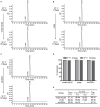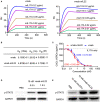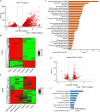A Novel Bifunctional Fusion Protein, Vunakizumab-IL22, for Protection Against Pulmonary Immune Injury Caused by Influenza Virus
- PMID: 34504501
- PMCID: PMC8421727
- DOI: 10.3389/fimmu.2021.727941
A Novel Bifunctional Fusion Protein, Vunakizumab-IL22, for Protection Against Pulmonary Immune Injury Caused by Influenza Virus
Abstract
Influenza A virus infection is usually associated with acute lung injury, which is typically characterized by tracheal mucosal barrier damage and an interleukin 17A (IL-17A)-mediated inflammatory response in lung tissues. Although targeting IL-17A has been proven to be beneficial for attenuating inflammation around lung cells, it still has a limited effect on pulmonary tissue recovery after influenza A virus infection. In this research, interleukin 22 (IL-22), a cytokine involved in the repair of the pulmonary mucosal barrier, was fused to the C-terminus of the anti-IL-17A antibody vunakizumab to endow the antibody with a tissue recovery function. The vunakizumab-IL22 (vmab-IL-22) fusion protein exhibits favorable stability and retains the biological activities of both the anti-IL-17A antibody and IL-22 in vitro. Mice infected with lethal H1N1 influenza A virus and treated with vmab-mIL22 showed attenuation of lung index scores and edema when compared to those of mice treated with saline or vmab or mIL22 alone. Our results also illustrate that vmab-mIL22 triggers the upregulation of MUC2 and ZO1, as well as the modulation of cytokines such as IL-1β, HMGB1 and IL-10, indicating the recovery of pulmonary goblet cells and the suppression of excessive inflammation in mice after influenza A virus infection. Moreover, transcriptome profiling analysis suggest the downregulation of fibrosis-related genes and signaling pathways, including genes related to focal adhesion, the inflammatory response pathway, the TGF-β signaling pathway and lung fibrosis upon vmab-mIL22 treatment, which indicates that the probable mechanism of vmab-mIL22 in ameliorating H1N1 influenza A-induced lung injury. Our results reveal that the bifunctional fusion protein vmab-mIL22 can trigger potent therapeutic effects in H1N1-infected mice by enhancing lung tissue recovery and inhibiting pulmonary inflammation, which highlights a potential approach for treating influenza A virus infection by targeting IL-17A and IL-22 simultaneously.
Keywords: H1N1 influenza A virus; IL-17A; IL-22; anti-inflammatory effects; bifunctional fusion protein; lung injury; tissue repair.
Copyright © 2021 Han, Shi, Zeng, Cen, Mei, Fan, Ju and Zhu.
Conflict of interest statement
The authors declare that the research was conducted in the absence of any commercial or financial relationships that could be construed as a potential conflict of interest.
Figures






Similar articles
-
Vunakizumab-IL22, a Novel Fusion Protein, Promotes Intestinal Epithelial Repair and Protects against Gut Injury Induced by the Influenza Virus.Biomedicines. 2023 Apr 12;11(4):1160. doi: 10.3390/biomedicines11041160. Biomedicines. 2023. PMID: 37189778 Free PMC article.
-
Houttuynia cordata polysaccharides ameliorate pneumonia severity and intestinal injury in mice with influenza virus infection.J Ethnopharmacol. 2018 May 23;218:90-99. doi: 10.1016/j.jep.2018.02.016. Epub 2018 Feb 19. J Ethnopharmacol. 2018. PMID: 29471085
-
Inhibition of the inflammatory cytokine tumor necrosis factor-alpha with etanercept provides protection against lethal H1N1 influenza infection in mice.Crit Care. 2013 Dec 27;17(6):R301. doi: 10.1186/cc13171. Crit Care. 2013. PMID: 24373231 Free PMC article.
-
Quelling the storm: utilization of sphingosine-1-phosphate receptor signaling to ameliorate influenza virus-induced cytokine storm.Immunol Res. 2011 Oct;51(1):15-25. doi: 10.1007/s12026-011-8240-z. Immunol Res. 2011. PMID: 21901448 Review.
-
The role of interleukin-22 in lung health and its therapeutic potential for COVID-19.Front Immunol. 2022 Jul 27;13:951107. doi: 10.3389/fimmu.2022.951107. eCollection 2022. Front Immunol. 2022. PMID: 35967401 Free PMC article. Review.
Cited by
-
Vunakizumab-IL22, a Novel Fusion Protein, Promotes Intestinal Epithelial Repair and Protects against Gut Injury Induced by the Influenza Virus.Biomedicines. 2023 Apr 12;11(4):1160. doi: 10.3390/biomedicines11041160. Biomedicines. 2023. PMID: 37189778 Free PMC article.
-
A Novel Bifunctional Fusion Protein (Anti-IL-17A-sST2) Protects against Acute Liver Failure, Modulating the TLR4/MyD88 Pathway and NLRP3 Inflammasome Activation.Biomedicines. 2024 May 17;12(5):1118. doi: 10.3390/biomedicines12051118. Biomedicines. 2024. PMID: 38791080 Free PMC article.
-
A bifunctional fusion protein protected against diabetic nephropathy by suppressing NLRP3 activation.Appl Microbiol Biotechnol. 2023 Apr;107(7-8):2561-2576. doi: 10.1007/s00253-023-12431-5. Epub 2023 Feb 27. Appl Microbiol Biotechnol. 2023. PMID: 36843198
-
Intestinal microbiota analysis and network pharmacology reveal the mechanism by which Lianhua Qingwen capsule improves the immune function of mice infected with influenza A virus.Front Microbiol. 2022 Nov 25;13:1035941. doi: 10.3389/fmicb.2022.1035941. eCollection 2022. Front Microbiol. 2022. PMID: 36504796 Free PMC article.
-
Current Knowledge of Th22 Cell and IL-22 Functions in Infectious Diseases.Pathogens. 2023 Jan 23;12(2):176. doi: 10.3390/pathogens12020176. Pathogens. 2023. PMID: 36839448 Free PMC article. Review.
References
Publication types
MeSH terms
Substances
LinkOut - more resources
Full Text Sources
Miscellaneous

